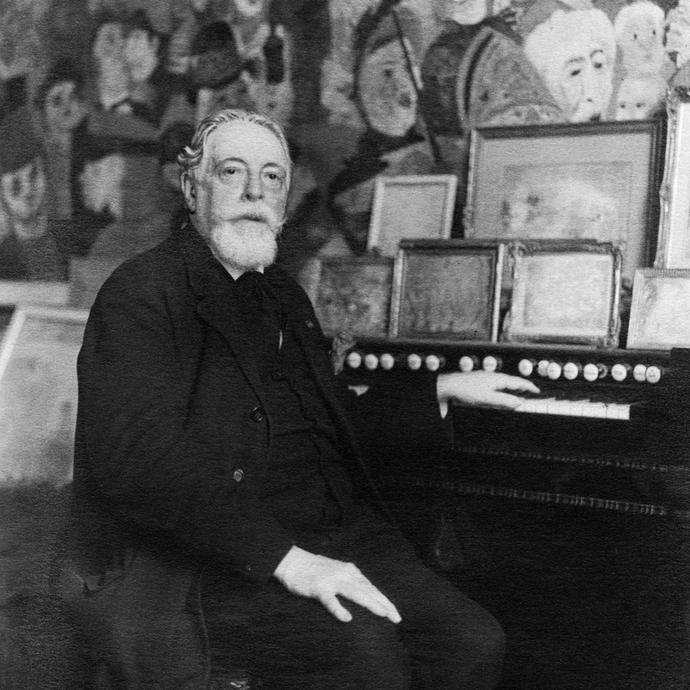
James Ensor
James Ensor, a celebrated Belgian artist, was a genuine pioneer of modern art, renowned for his vivid and eerie portrayals of masked skeletons, seascapes, and carnival scenes.
Biography of James Ensor
Born on April 13, 1860, in Ostend, Belgium, James Ensor pursued studies at the Académie Royale des Beaux-Arts in Brussels, where he challenged strict instruction and formed connections with like-minded students, including Théo van Rysselberghe.
Ensor's initial exhibition of his work took place in 1881. His studio was located in the attic of his parent's house from 1880 to 1917.
He was associated with the artistic group Les XX, a group of 20 Belgian artists meant to promote international modern art. Despite being a founding member of this group, Ensor faced rejection by them for his masterpiece "Christ's Entry into Brussels" in 1889. This monumental painting, measuring 99 by 169 inches, depicts a raucous carnival crowd with the almost imperceptible Christ-like figure at the center, overlooked by the surrounding mob. A critique of Belgian society, it foreshadows the 20th-century expressionist movement. Despite being misunderstood even by the avant-garde Les XX, Ensor safeguarded the artwork in his studio until its unveiling in 1929 during a major retrospective of his work in Brussels.
Ensor's mastery extended beyond painting; his oeuvre encompassed 133 etchings created between 1886 and 1904. Some of these works served as preparatory pieces for his paintings, while others were original compositions. His academic training added robustness to his engraving skills, and his meticulous approach resulted in prints of exceptional quality. Ensor occasionally embellished his etchings with color, using diverse techniques like pencils, watercolors, and gouache. His satirical critique of society shone through, maintaining the essence of his personal style.
In urgent need of financial resources, the artist began using his etchings as a form of currency exchange in Ostend. As his reputation grew, local shopkeepers eagerly accepted his work as payment for their services. He traded his artwork for goods at various establishments, including the bakery, butcher's shop, drugstore, and bar. Following a personal crisis in the 1890s, after selling all contents of his studio, he temporarily abandoned painting, only to return to it within a few years. By the early 20th century, his fame had spread throughout Europe, thanks to influential artists such as Paul Klee, George Grosz, and Alfred Kubin.
Like many visionaries, James Ensor's brilliance outpaced his time. Recognition for his artistic prowess arrived only in the waning days of his life. Initially, the public and critics failed to fully grasp the potency of his grotesque figures and vibrant palettes. His fame burgeoned primarily in the 1920s-30s.
On November 19, 1949, James Ensor passed away in Ostend, Belgium. His artistic legacy resides within the esteemed collections of institutions such as the Art Institute of Chicago, the Metropolitan Museum of Art in New York, the Musée d’Orsay in Paris, the Neue Pinakothek in Munich, and the Tate Gallery in London, alongside various other venues worldwide.
Ahead of his time, his art was misunderstood by the public, but today, James Ensor stands as a true trailblazer of modern art.
James Ensor's Art Style
Mirroring the fascination shared by many European artists of the late 19th century, James Ensor nurtured a deep interest in Far Eastern artistry. His mother's shop allowed him to engage with Japanese imports, sparking a revolution in his artistic expression. Carnival masks mingled harmoniously with traditional Japanese Noh theater masks, an infusion that liberated his work from Western artistic norms and representation of beauty.
From the 1880s onward, masks emerged as a defining motif in Ensor's paintings. These carnival visages bore profound symbolism, representing distorted societal relationships he critiqued in the society of his time. Grotesque masks, disfigured and haunting, embodied humankind's darker facets. The looming figure of Death often stood beside them, a poignant reminder of mortality.
Identifying himself as an heir of the ancient Flemish Masters, the artist incorporated some of their satirical motifs, particularly scatological imagery, transmuting them into a more politically charged voice. Old Masters such as Pieter Brueghel the Elder and Hieronymous Bosch largely inspired his work. Analogies reverberate between their canvases, populated by fantastic and demoniac beasts and grotesque figures, and Ensor’s paintings. Nevertheless, Ensor infused his creations with modernity.
The artist also attributed his artistic drive to literature, finding camaraderie among Symbolist writers like Edmond Picard and Albert Mockel. His oeuvre bore a profound affinity with Belgian Symbolist literature.
Years:
Born in 1860
Country:
Belgium, Ostend
Gallery: